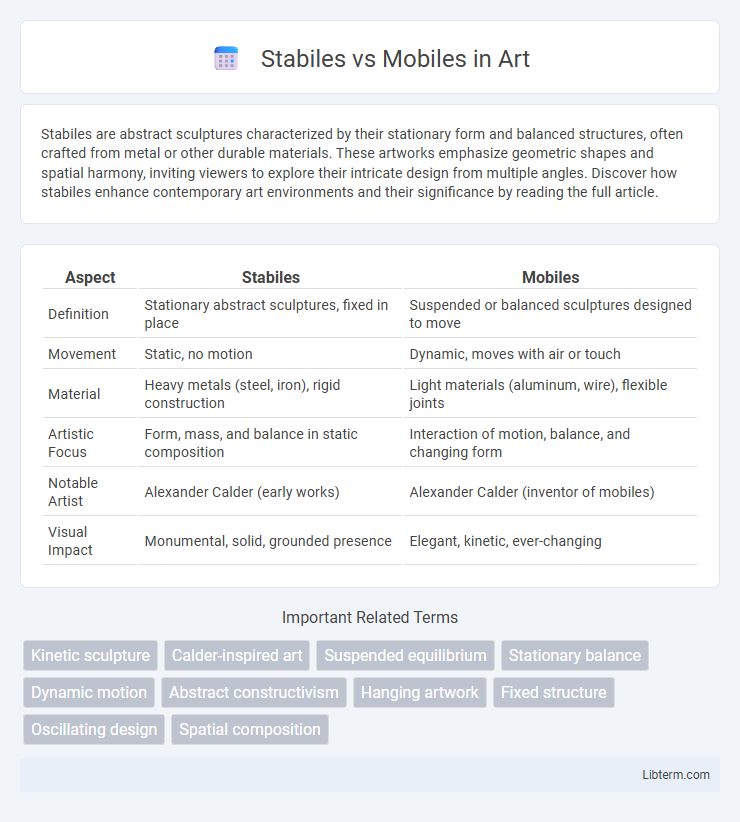Stabiles are abstract sculptures characterized by their stationary form and balanced structures, often crafted from metal or other durable materials. These artworks emphasize geometric shapes and spatial harmony, inviting viewers to explore their intricate design from multiple angles. Discover how stabiles enhance contemporary art environments and their significance by reading the full article.
Table of Comparison
| Aspect | Stabiles | Mobiles |
|---|---|---|
| Definition | Stationary abstract sculptures, fixed in place | Suspended or balanced sculptures designed to move |
| Movement | Static, no motion | Dynamic, moves with air or touch |
| Material | Heavy metals (steel, iron), rigid construction | Light materials (aluminum, wire), flexible joints |
| Artistic Focus | Form, mass, and balance in static composition | Interaction of motion, balance, and changing form |
| Notable Artist | Alexander Calder (early works) | Alexander Calder (inventor of mobiles) |
| Visual Impact | Monumental, solid, grounded presence | Elegant, kinetic, ever-changing |
Introduction to Stabiles and Mobiles
Stabiles and mobiles are two distinct forms of kinetic sculpture, with stabiles characterized by their stationary, balanced steel structures anchored to the ground, often associated with artist Alexander Calder. Mobiles, also pioneered by Calder, consist of delicately balanced, moving parts that respond to air currents, creating dynamic visual experiences. Both forms revolutionized modern sculpture by incorporating movement and abstract shapes, transforming static art into interactive visual expressions.
Definitions: What Are Stabiles and Mobiles?
Stabiles are stationary sculptures characterized by their fixed positions and abstract forms, often made from heavy metals like steel or iron to ensure durability and stability in outdoor spaces. Mobiles, in the other hand, are kinetic sculptures designed to move with air currents, featuring balanced components connected by wires, typically crafted from lightweight materials such as aluminum or thin steel. Both forms originated in the 20th century and are closely associated with artists like Alexander Calder, who pioneered the dynamic contrast between stability and motion in sculpture art.
Historical Origins and Key Artists
Stabiles originated in the 1930s as stationary abstract sculptures characterized by their large, solid forms, pioneered by artist Alexander Calder who coined the term and differentiated them from his dynamic mobiles. Mobiles, also developed by Calder around the same time, emphasize kinetic movement through delicately balanced components that shift with air currents, reflecting a key shift toward interactive and dynamic art forms. Other influential artists in these categories include Jean Arp and Marcel Duchamp for abstract stabiles, and artists like Laszlo Moholy-Nagy contributed to the kinetic principles embraced in mobiles.
Structural Differences: Balance and Movement
Stabiles are stationary sculptural forms characterized by fixed bases that provide structural balance without movement, often relying on heavy materials like steel or bronze to maintain stability. Mobiles incorporate delicate, suspended components connected by rods or wires, allowing parts to pivot and move freely, creating dynamic equilibrium through balanced mass distribution. The key structural difference lies in stabiles' fixed, grounded framework versus mobiles' kinetic design enabling continuous movement driven by subtle environmental forces like air currents.
Materials and Construction Techniques
Stabiles are constructed primarily from heavy, industrial-grade materials like steel and iron, featuring welded or bolted joints that provide structural integrity and durability for static display. Mobiles utilize lightweight materials such as aluminum, wire, and paper or thin metal sheets, with delicate balancing techniques and flexible joints enabling dynamic movement. Construction of stabiles emphasizes mass and permanence, while mobiles rely on precise weight distribution and flexible connections to achieve kinetic motion.
Artistic Purposes and Aesthetic Appeal
Stabiles, created as stationary sculptures, emphasize artistic purposes by providing a fixed focal point that invites prolonged contemplation and interaction with space, enhancing their aesthetic appeal through stability and form. Mobiles, designed to move with air currents, introduce dynamic motion, offering a constantly changing visual experience that highlights balance and fluidity, enriching their artistic presence. Both forms play distinct roles in modern art by exploring the relationship between movement, space, and viewer engagement.
Popular Styles and Iconic Examples
Stabiles and mobiles represent two distinct styles of kinetic sculpture, with stabiles being stationary and characterized by abstract, often geometric shapes made of welded metal, epitomized by Alexander Calder's large-scale outdoor works like "Eagle" (1971). Mobiles, also pioneered by Calder, feature delicately balanced, moving components suspended in the air, exemplified by "Lobster Trap and Fish Tail" (1939), which highlight fluid motion and interplay with air currents. Both styles have become iconic within modern art, influencing public sculpture and transforming spatial dynamics through their contrasting approaches to movement and form.
Display Considerations: Indoors vs Outdoors
Stabiles typically feature heavier, more durable materials ideal for stable indoor displays where environmental factors are controlled, ensuring consistent appearance and longevity. Mobiles are designed with lightweight materials and balanced structures to withstand outdoor elements like wind and sunlight, providing dynamic movement without compromising stability. Display considerations also involve visibility; stabiles benefit from focused indoor lighting while mobiles require weather-resistant finishes and colorfast materials to maintain vibrancy outdoors.
Collecting and Preserving Stabiles and Mobiles
Collecting and preserving stabiles and mobiles requires distinct approaches due to their structural differences; stabiles, being stationary sculptures, demand stable environments with controlled humidity and temperature to prevent corrosion and material degradation. Mobiles, characterized by their kinetic components, require careful handling and specialized supports to maintain balance while avoiding stress on moving parts and delicate joints. Proper conservation techniques include regular cleaning, gentle lubrication of joints in mobiles, and using inert materials for mounting stabiles to ensure long-term preservation.
Stabiles vs Mobiles: Choosing the Right Artform
Stabiles and mobiles represent two distinct art forms, with stabiles being stationary abstract sculptures often constructed from steel or metal, emphasizing balance and solidity. Mobiles are kinetic sculptures designed to move with air currents, showcasing dynamic motion and lightness through suspended components. Selecting between stabiles and mobiles depends on the desired interaction with space: stabiles anchor environments with stability, while mobiles introduce fluidity and movement.
Stabiles Infographic

 libterm.com
libterm.com